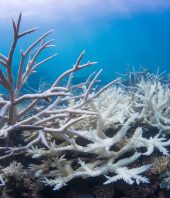Nicholas Ogle stands at the water’s edge on Florida International University’s Biscayne Bay campus and holds what looks like a giant, rotten green bean out to the crowd of teenagers in front of him.
“We don’t want any mushiness anywhere, especially at the top,” he says, and chucks the specimen to the side.
Ogle, an environmental coordinator with FIU, is showing this high school marine-science class from the new MAST magnet school at FIU how to pick out a healthy mangrove seedling. The students will then be sent to duck in and out of the mangrove roots at the coastline, collecting seedlings — “propagules,” the scientist calls them — to eventually be replanted in a mangrove restoration project.
Mangroves are often cited as a first line of defense against the impact of sea-level rise. And in many ways, so is this interaction between the students and Ogle.
Florida doesn’t require students to learn about the effects of climate change — like sea-level rise — until high school. But in South Florida, kids observe sea-level rise all around them. They see it on television, online and in person. According to the National Oceanic and Atmospheric Administration, the sea level in Miami has risen more than nine inches over the past hundred years — and scientists expect a lot more in the next hundred.
So South Florida schools and outside organizations are forming partnerships to build an educational bridge connecting what students learn in school and what they see in their changing environments.
INTO THE CLASSROOM
“To have kids be outside, to see what life is like around here in the natural world … that really shapes the way they’re going to be in the future,” says Kirk Nieveen, a science curriculum support specialist for Miami-Dade County Public Schools.
Nieveen says South Florida schools introduce local climate science as early as elementary school. Miami-Dade County alone has 66 schools that offer environmental or marine sciences. There are 13 magnet schools, including the MAST school at FIU, that are focused on the environment.
“You don’t want to scare kids,” says Nieveen, “but at the same time you want them to become aware of things.”
He was pleasantly surprised to see recent news coverage of Miami Beach’s King Tide that looked a lot like tidal modeling that’s taught in Miami-Dade schools.
“We build the foundation within school curriculums and then also provide opportunities for kids to get involved locally,” says Nieveen.
Those opportunities often come from partnerships with environmental nonprofit groups, such as the environmental curriculum offered through the Fairchild Challenge at Fairchild Tropical Botanic Garden, or the Everglades field trips led by the Arthur R. Marshall Foundation.
Mary Crider, an education specialist with the Marshall Foundation, recently designed a sea-level rise curriculum that she plans to bring to classrooms across South Florida. She says empowering students to act on seal-level rise is key to helping them learn without making them feel overwhelmed and defeated.
“There’s kind of phases that they go through when they get all this information,” says Crider. “The first one is kind of just, ‘Oh my gosh, this is going to happen? I think I’ll just ignore it.’ The next phase, they’re like, ‘Okay, I think I can absorb this information, but now what can I do?’ ”
To that end, Crider gives students a list of next steps that includes tips like: Document what you see on social media; talk to family and friends about what you’ve learned; and partner with local clubs, libraries and science museums.
YOUNG AND INTERESTED
It’s an approach that’s worked for Miami Beach resident Alejandra Andavert-Seemann.
Alejandra is a 9-year-old who carries business cards. She likes spending her weekends picking up trash on the beach with her best friend. Sometimes she brings her dog.
Last year, Alejandra ran for third-grade class president on a platform focusing on sea turtles. When she won, she followed through on her campaign promise and helped the class adopt three sea turtles: Turtle Lee, Marmalade and Toby.
She’s concerned about sea-level rise. She worries that the ice caps will melt and the polar bears will die. She worries that the land in her neighborhood will be under water.
“Yeah, I’m worried,” says Alejandra. She says she tries not to think about it too much. She thinks we can do a better job of preventing it: “I think we should try to tell people and put signs up, or make it that we have to stop littering. And try to help the environment more.”
“I think sometimes Alejandra gets a little too concerned and you want to make sure it’s something under her control,” says Alejandra’s mom, Stephanie. “We talk about cleaning bottle caps off the beach, plastic bags out of the water — things under her control.”
FUTURE GENERATIONS
Corbin Bolies can’t remember when he first learned about sea-level rise. It’s just part of the 15-year-old’s life.
“By the time my children have their own children, the coastline’s gonna be gone,” says Bolies as he watches his MAST classmates root around mangroves looking for seedlings.
He thinks most adults don’t really get it. Not yet.
“But as they learn more about it, as it’s coming on the news, I feel they’ll start worrying,” says Bolies.
And when they do, he’ll be ready to help them. “It’s us that’s making the sea level rise along with natural factors, but we as humans should feel compelled to help restore our earth to its natural beauty.”






